|
Day 1: June 22, 2005 |
Prev Next |
|
Day 1: June 22, 2005 |
Prev Next |
|
|
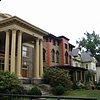
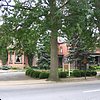
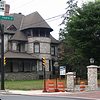 I'll start things off by telling you what I did not do. I did not ride the
Williamsport trolleys. Nearly a year ago, on my first visit to
Williamsport, I rode the Hiawatha river boat and learned that it was one of the
stops for trolleys that provide a land-based view of the town's history. I
tried to purchase a ticket as soon as the boat docked but found out that I
had already missed the last run of the day. Two subsequent visits were
during the winter when the trolleys do not run at all. It was around 4:00
when I left the customer site yesterday and I thought I might catch a
trolley tour. Nope, the last departure was at 2:15. Maybe today before
leaving town. Nope, it's Wednesday. The trolleys run only on Tuesdays,
Thursdays, and Saturdays. So I treated myself to a drive/walk along what I
knew to be part of the trolley route - Millionaire's Row.
I'll start things off by telling you what I did not do. I did not ride the
Williamsport trolleys. Nearly a year ago, on my first visit to
Williamsport, I rode the Hiawatha river boat and learned that it was one of the
stops for trolleys that provide a land-based view of the town's history. I
tried to purchase a ticket as soon as the boat docked but found out that I
had already missed the last run of the day. Two subsequent visits were
during the winter when the trolleys do not run at all. It was around 4:00
when I left the customer site yesterday and I thought I might catch a
trolley tour. Nope, the last departure was at 2:15. Maybe today before
leaving town. Nope, it's Wednesday. The trolleys run only on Tuesdays,
Thursdays, and Saturdays. So I treated myself to a drive/walk along what I
knew to be part of the trolley route - Millionaire's Row.
In the latter half of the nineteenth century, when Williamsport was the lumber capitol of the world, the town was home to more millionaires per capita than anywhere in the country. Many of these wealthy residents built their homes along Fourth Street is a section east of downtown and that section has the well deserved name of Millionaire's Row. Geographically, Millionaire's Row starts at Elmira Street with the A. D. Hermance house. Pillars are being erected whose purpose seems to be providing an "entrance" to the Row. The 1855 Hermance house is just a year newer than the Herdic house next to it. Peter Herdic is one of the biggest of the era's lumber barons and his home is now the Peter Herdic House Restaurant - one of Williamsport's more upscale dining establishments. The third picture shows that mansions really do stand in rows here. There are other exceptions like the Herdic House but many of these huge homes have become "student housing" and no longer get the attention their owners once gave them. |
|
|
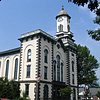
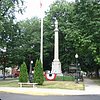
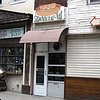
 I crossed over the Susquehanna River and left Williamsport on US-15. Some
thirty miles later, I picked up PA-61 and re-crossed the river into
the town of Sunbury. I stopped because the Northumberland County court
house caught my eye and then enjoyed walking around the park like area
that forms the center of a long traffic oval. I started to drive out of
town but just had to stop at the aptly named Squeeze-In. The
restaurant/hotdog stand is no more than eight feet wide and offers seating
for five. Shawn Sterling, whose family has owned an operated the place
since 1945, told me that about 270 pounds of hotdogs will be sold here in
a typical week. There is a fireman's convention in Sunbury this week and
the Sterlings are expecting to move 400 pounds of tube-steak. Needless to
say, most of that will be take-out.
I crossed over the Susquehanna River and left Williamsport on US-15. Some
thirty miles later, I picked up PA-61 and re-crossed the river into
the town of Sunbury. I stopped because the Northumberland County court
house caught my eye and then enjoyed walking around the park like area
that forms the center of a long traffic oval. I started to drive out of
town but just had to stop at the aptly named Squeeze-In. The
restaurant/hotdog stand is no more than eight feet wide and offers seating
for five. Shawn Sterling, whose family has owned an operated the place
since 1945, told me that about 270 pounds of hotdogs will be sold here in
a typical week. There is a fireman's convention in Sunbury this week and
the Sterlings are expecting to move 400 pounds of tube-steak. Needless to
say, most of that will be take-out.
|
|
|

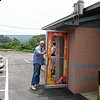

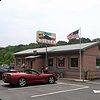 I spotted Palmer's Diner at the east edge of Shamokin and pulled in for
lunch. The diner has been here since 1947 although the original burned in
1981 and was rebuilt from the ground up. It as always been a Palmer family
operation and two generations of the family can be seen at work in the
second picture. This is not a manufactured diner, even the original was
built on site, but it is setup just like a diner is supposed to be. A few
stools (10), a few booths, and the grill out front where customers can
watch the cook and vice versa. As I took some pictures of the outside,
this fellow arrived and asked "How about one with me in it?"
"Sure thing", I responded and realized he was serious when he
paused at the door. Good picture, eh?
I spotted Palmer's Diner at the east edge of Shamokin and pulled in for
lunch. The diner has been here since 1947 although the original burned in
1981 and was rebuilt from the ground up. It as always been a Palmer family
operation and two generations of the family can be seen at work in the
second picture. This is not a manufactured diner, even the original was
built on site, but it is setup just like a diner is supposed to be. A few
stools (10), a few booths, and the grill out front where customers can
watch the cook and vice versa. As I took some pictures of the outside,
this fellow arrived and asked "How about one with me in it?"
"Sure thing", I responded and realized he was serious when he
paused at the door. Good picture, eh?
|
|
|
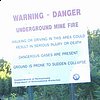
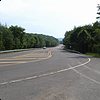
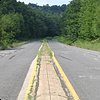
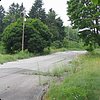
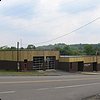
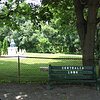 This is one of the trip's preplanned destinations. In 1962 a fire was
accidentally started in a seam of coal underneath the town of
Centralia. Over forty years later, the fire still
burns and probably will until the last few residents leave and the fire
can be attacked by extensive excavation. About 400 residents have accepted
the government buyout but ten or so are still holding on. I quickly
realized that looking at an underground fire is a lot like watching
submarine races. Here there are abandoned streets running by lots where
the houses have already been leveled. Centralia's Municipal Building still
stands and there are even emergency vehicles parked inside but there is no
one to drive them. The well cared for park like setting is across the
street from some of the few remaining houses. Freshly mowed grass
surrounds the veterans memorial with new flags waving. The stone behind
the bench marks a time capsule with eleven years
yet to go.
This is one of the trip's preplanned destinations. In 1962 a fire was
accidentally started in a seam of coal underneath the town of
Centralia. Over forty years later, the fire still
burns and probably will until the last few residents leave and the fire
can be attacked by extensive excavation. About 400 residents have accepted
the government buyout but ten or so are still holding on. I quickly
realized that looking at an underground fire is a lot like watching
submarine races. Here there are abandoned streets running by lots where
the houses have already been leveled. Centralia's Municipal Building still
stands and there are even emergency vehicles parked inside but there is no
one to drive them. The well cared for park like setting is across the
street from some of the few remaining houses. Freshly mowed grass
surrounds the veterans memorial with new flags waving. The stone behind
the bench marks a time capsule with eleven years
yet to go.
|
|
|
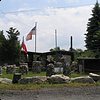 While exploring around Centralia, I found this display in nearby Aristes.
The sign reads "IN MEMORY TO THE CENTRALIA COAL MINERS". I don't
know if this refers to the fire that emptied the town or to some other
tragedy.
While exploring around Centralia, I found this display in nearby Aristes.
The sign reads "IN MEMORY TO THE CENTRALIA COAL MINERS". I don't
know if this refers to the fire that emptied the town or to some other
tragedy.
|
|
|
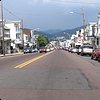
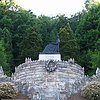
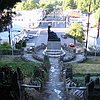 This is the long, narrow, and sloping town of Ashland, PA. At the bottom,
where PA-61 turns, stands a unique monument to motherhood. This bronze
representation of Whistlers Mother was erected by the Ashland Boys
Association in 1938.
This is the long, narrow, and sloping town of Ashland, PA. At the bottom,
where PA-61 turns, stands a unique monument to motherhood. This bronze
representation of Whistlers Mother was erected by the Ashland Boys
Association in 1938.
|
|
|
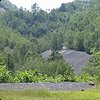
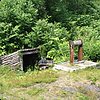
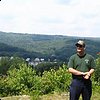
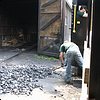
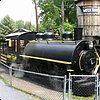 Also in Ashland is the Pioneer Tunnel Coal Mine & Steam Train. The steam
train is a 1927 model that runs on something in good supply around here.
The engine and the cars (minus the padded benches, etc.) were used in the
actual mining operations. The train makes a couple of stops one of which
overlooks the town of Ashland. Here the guide points out Centralia a
couple of miles away and tells us that, if it were raining, we would see
steam rising from the underground fire. There is also a reconstruction of
a bootleg coal operation and a view of a real strip mine site. During the
depression, out of work miners would manually dig tunnels into the earth
to scratch out coal which they hoped to sell for around $3 a ton. The
activity was definitely illegal and confrontations definitely occurred.
The last pictures shows where a hill once stood. Big steam shovels
stripped the earth covering from the top of a vein of coal and then dug at
the vein itself.
Also in Ashland is the Pioneer Tunnel Coal Mine & Steam Train. The steam
train is a 1927 model that runs on something in good supply around here.
The engine and the cars (minus the padded benches, etc.) were used in the
actual mining operations. The train makes a couple of stops one of which
overlooks the town of Ashland. Here the guide points out Centralia a
couple of miles away and tells us that, if it were raining, we would see
steam rising from the underground fire. There is also a reconstruction of
a bootleg coal operation and a view of a real strip mine site. During the
depression, out of work miners would manually dig tunnels into the earth
to scratch out coal which they hoped to sell for around $3 a ton. The
activity was definitely illegal and confrontations definitely occurred.
The last pictures shows where a hill once stood. Big steam shovels
stripped the earth covering from the top of a vein of coal and then dug at
the vein itself.
|
|
|
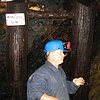
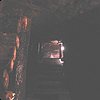
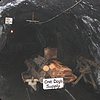
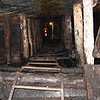
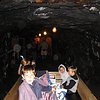 After the steam powered ride, I boarded an electric powered train for a
ride over a quarter of a mile into Mahonoy Mountain. Our guide, Rick,
explains just how anthracite is mined. My idea of coal mining was
"pick & shovel" digging but anthracite coal is too hard to
do that on any significant scale. Anthracite is mined "bottom
up" by tunneling horizontally through the veins and working upward
with drills and explosives. The underground darkness (It was black as
coal!) was too much for my feeble flash but that didn't stop me. The
second picture is attempting to show an upward pointing shaft. A typical
days work for a pair of miners would be to extend the shaft another six
feet. To accomplish that, they would first put braces in the space they
had opened the day before. Next they would extend the wooden ladder that
got them there. Now they started drilling with long hand powered bits.
Once the holes were deep enough, it was time to place the dynamite, light
the fuse, and scramble down that ladder to a safe spot. Wood for braces
and ladder had to be carried as much as 400 feet up that same ladder by
those same two miners. About 300 pounds of lumber make up a day's supply.
The fourth picture shows a shaft where a modern metal ladder has replaced
the old wooden one. This is our emergency escape route should the main
tunnel become blocked.
After the steam powered ride, I boarded an electric powered train for a
ride over a quarter of a mile into Mahonoy Mountain. Our guide, Rick,
explains just how anthracite is mined. My idea of coal mining was
"pick & shovel" digging but anthracite coal is too hard to
do that on any significant scale. Anthracite is mined "bottom
up" by tunneling horizontally through the veins and working upward
with drills and explosives. The underground darkness (It was black as
coal!) was too much for my feeble flash but that didn't stop me. The
second picture is attempting to show an upward pointing shaft. A typical
days work for a pair of miners would be to extend the shaft another six
feet. To accomplish that, they would first put braces in the space they
had opened the day before. Next they would extend the wooden ladder that
got them there. Now they started drilling with long hand powered bits.
Once the holes were deep enough, it was time to place the dynamite, light
the fuse, and scramble down that ladder to a safe spot. Wood for braces
and ladder had to be carried as much as 400 feet up that same ladder by
those same two miners. About 300 pounds of lumber make up a day's supply.
The fourth picture shows a shaft where a modern metal ladder has replaced
the old wooden one. This is our emergency escape route should the main
tunnel become blocked.
|
|
|
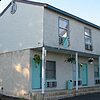
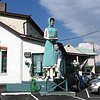 I knew of this rather unnerving statue from
RoadsideAmerica.com but I didn't realize that it
marked a real motel. I booked a room and enjoyed dinner here and will
likely have breakfast here, too. Guest rooms and dining areas are indeed
decorated in a homey style that fits the name
"Granny's Motel
& Restaurant" and, glimpsed from a passing car, the bonneted
statue might even look like a friendly granny. But up close, the wide-eyed
figure looks more lost than loving and whatever is holding the headless
doll is hardly childlike. However, the rooms are comfortable, the food is
tasty, and the beer is cold.
I knew of this rather unnerving statue from
RoadsideAmerica.com but I didn't realize that it
marked a real motel. I booked a room and enjoyed dinner here and will
likely have breakfast here, too. Guest rooms and dining areas are indeed
decorated in a homey style that fits the name
"Granny's Motel
& Restaurant" and, glimpsed from a passing car, the bonneted
statue might even look like a friendly granny. But up close, the wide-eyed
figure looks more lost than loving and whatever is holding the headless
doll is hardly childlike. However, the rooms are comfortable, the food is
tasty, and the beer is cold.
|
|
|